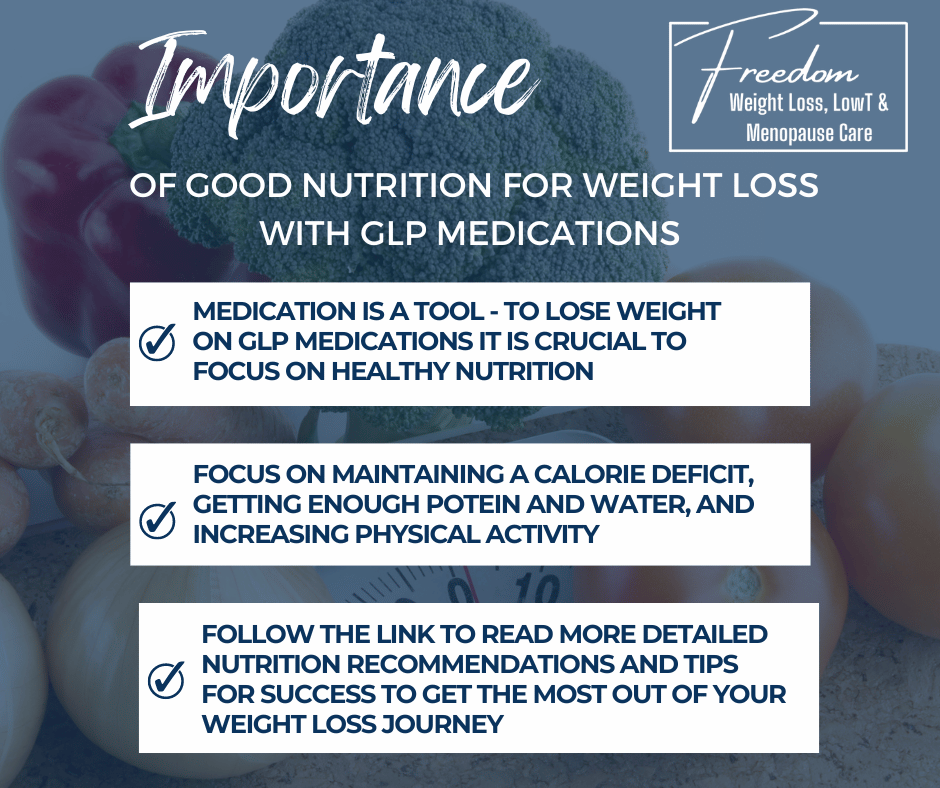As you continue your weight loss journey with the support of GLP-1 medications, we want to help you understand the crucial role that nutrition plays in achieving your goals. Medication is a tool and good nutrition is necessary for the medication to be effective.
Following are some helpful guidelines and tips about important aspects of a healthy, balanced nutrition plan including macronutrient balance, calorie intake, and mindful eating practices.
Taking a few minutes to review this information and incorporate it into your daily routine will help you to get the most out of your weight loss program.
Calorie Goals – Consistent Moderate Calorie Reduction:
- Aim to reduce your daily caloric intake by 500 to 1,000 calories from your maintenance level to achieve a weight loss of about 1 to 2 pounds per week.
- For Women, typically 1200-1500 calories per day
- For Men, typically 1500-1800 calories per day
- There are many free online calculators you can use to get goals for calories and macros that are more specific to your body weight and activity level, accounting for your Basal Metabolic Rate (BMR). A good one can be found at https://tdeemacros.com/
Protein Intake:
- Aim for 1.2 to 1.6 grams of protein per kilogram of body weight per day.
- Focus on lean protein sources like chicken, turkey, fish, beans, legumes, and low-fat dairy.
- Include protein in every meal to support muscle maintenance and promote satiety.
Carbohydrate Intake:
- Target 45-55% of your total daily calories from carbohydrates.
- Prioritize complex carbohydrates such as whole grains, vegetables, fruits, and legumes.
- Limit intake of refined sugars and simple carbs like white bread, pastries, and sugary drinks.
Fat Intake:
- Keep fats to 20-35% of your total daily calories.
- Choose healthy fats from sources like avocados, nuts, seeds, olive oil, and fatty fish.
- Limit saturated and trans fats found in processed and fried foods.
Fiber:
- Aim for at least 25-30 grams of fiber per day.
- High-fiber foods include vegetables, fruits, whole grains, and legumes.
- Fiber helps with digestion, promotes fullness, and can improve blood sugar control.
- Many people benefit from an over the counter daily fiber supplement.
Hydration:
- Drink plenty of water throughout the day, aiming for at least 8 cups (64 ounces).
- Water helps maintain hydration, supports metabolic processes, and can aid in appetite control.
Meal Timing:
- Eat regular, balanced meals and snacks to maintain steady energy levels.
- Avoid skipping meals, which can lead to overeating later.
- Consider smaller, more frequent meals if it helps manage hunger and portion sizes.
Mindful Eating:
- Practice mindful eating by paying attention to hunger and fullness cues.
- Avoid distractions like TV or smartphones while eating to help recognize when you’re full.
Portion Control:
- Be mindful of portion sizes to avoid overeating.
- Use smaller plates and bowls to help control portions visually.
- Measure and weigh food portions if necessary to ensure accuracy.
Alcohol:
- Limit alcohol intake as it can add empty calories and affect blood sugar levels.
- If you choose to drink, do so in moderation (up to one drink per day for women and two for men).
Consistency:
- Stick to a consistent eating pattern that fits your lifestyle and preferences.
- Remember that gradual, sustainable changes are more effective than drastic diets.
Monitor Progress:
- Keep track of your food intake, physical activity, and progress to stay motivated and make adjustments as needed.





